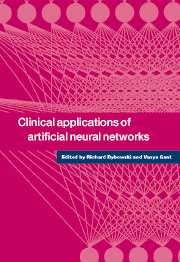Book contents
- Frontmatter
- Contents
- List of contributors
- 1 Introduction
- Part I Applications
- 2 Artificial neural networks in laboratory medicine
- 3 Using artificial neural networks to screen cervical smears: how new technology enhances health care
- 4 Neural network analysis of sleep disorders
- 5 Artificial neural networks for neonatal intensive care
- 6 Artificial neural networks in urology: applications, feature extraction and user implementations
- 7 Artificial neural networks as a tool for whole organism fingerprinting in bacterial taxonomy
- Part II Prospects
- Part III Theory
- Part IV Ethics and clinical prospects
- Index
3 - Using artificial neural networks to screen cervical smears: how new technology enhances health care
Published online by Cambridge University Press: 06 October 2009
- Frontmatter
- Contents
- List of contributors
- 1 Introduction
- Part I Applications
- 2 Artificial neural networks in laboratory medicine
- 3 Using artificial neural networks to screen cervical smears: how new technology enhances health care
- 4 Neural network analysis of sleep disorders
- 5 Artificial neural networks for neonatal intensive care
- 6 Artificial neural networks in urology: applications, feature extraction and user implementations
- 7 Artificial neural networks as a tool for whole organism fingerprinting in bacterial taxonomy
- Part II Prospects
- Part III Theory
- Part IV Ethics and clinical prospects
- Index
Summary
Screening for carcinoma of the cervix
In this chapter, we present our experience of 9 years of using neural network technology to screen for cervical carcinoma. In 1928 Papanicolaou presented in Battle Creek, Michigan, his chance observation that cervical cancer cells can be found in a vaginal smear. He realized that the method could be used to recognize cervical carcinoma and treat it in its early stages thereby preventing death from cancer in these women. In addition, he found that the preinvasive stages of cervical carcinoma could be detected in the smear. Removal of the abnormal tissue at this stage before spread would in essence therefore provide ‘curative’ treatment. Mass screening of asymptomatic women to detect cervical carcinoma at a curable stage began in the USA in 1945. Abnormal cells were to be detected in cervical smears by trained cytotechnologists, cytologists, or pathologists by means of light microscopy, a technique still used in the vast majority of modern laboratories.
Human screening is far from ideal as cancer cells can easily be overlooked, resulting in a ‘false negative’ diagnosis. The risk of consequent litigation has become a major concern within the cytology community in the USA (Frable 1994; DeMay 1996) and Australia (Mitchell 1995). Significant laboratory incidents with adverse medicolegal consequences have also been reported in the UK (Cogan 2000). One of the approaches taken to facilitate the detection of abnormal cells in cervical smears has been the application of neural network technology.
- Type
- Chapter
- Information
- Clinical Applications of Artificial Neural Networks , pp. 81 - 89Publisher: Cambridge University PressPrint publication year: 2001
- 1
- Cited by



